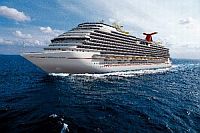 Ebola hysteria continues to spiral out of control. A nurse, who may have handled lab specimens from an Ebola patient at Texas Presbyterian Hospital in Dallas, is now being quarantined in her stateroom on the cruise ship, Carnival Magic. The ship, in turn, has been refused entry into Belize. The government of Belize also denied a request to evacuate the nurse through the airport in Belize City. The shares of both Carnival and Royal Caribbean dropped 5% on the news.
Ebola hysteria continues to spiral out of control. A nurse, who may have handled lab specimens from an Ebola patient at Texas Presbyterian Hospital in Dallas, is now being quarantined in her stateroom on the cruise ship, Carnival Magic. The ship, in turn, has been refused entry into Belize. The government of Belize also denied a request to evacuate the nurse through the airport in Belize City. The shares of both Carnival and Royal Caribbean dropped 5% on the news.
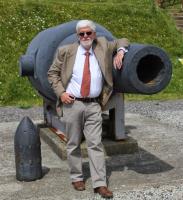 In December, Antione Vanner’s “Britannia’s X,” the third of his Dawlish chronicles will be published by Old Salt Press. No, the book’s title will not be “Britannia’s X.” From Antoine’s Dawlish Chronicles blog:
In December, Antione Vanner’s “Britannia’s X,” the third of his Dawlish chronicles will be published by Old Salt Press. No, the book’s title will not be “Britannia’s X.” From Antoine’s Dawlish Chronicles blog:
The title, for now, is “Britannia’s X” – with “X” being undisclosed for now. I’m therefore offering signed copies of the novel to the first three successful guesses as to what “X” stands for. The first two books in the series have been Britannia’s Wolf and Britannia’s Reach, so what could the “X” possibly be?
The only clues I’m offering are (a) that the action covers the period April – September1881, (b) that the adventure (and nightmare!) starts in the Northern Adriatic but shifts continents thereafter and (c) that Nicholas Dawlish’s intrepid wife, Florence, plays a key role.
Go to Antione’s blog to learn more: Competition Announcement: 3rd Dawlish Chronicles Novel launching soon.

A diver wearing a robotic Exosuit near Antikythera. (EPA/Greek Ministry of Culture)
The quote by Brendan Foley of the Woods Hole Oceanographic Institution was pure marketing genius. He said that the Antikythera wreck is “the Titanic of the ancient world.” The Titanic is, after all, the rock star of ship wrecks. No doubt what Foley meant was that the Antikythera wreck was very important historically not unlike the Titanic. Of course, that is not what the media has interpreted the quote to mean.
UPI is referring to the wrecked ship as a “sort of luxury ocean liner.” The Guardian called it ” a luxury liner dating from before the Roman empire.” Because the site is also the source of the Antikythera mechanism, an astronomic calculator of mind-boggling complexity, often referred to as the “world’s oldest computer,” one news source is referring to the wreck as the “Computerized Titanic,” which conjures up a whole new set of images.
 We all know Murphy’s Law — “That which can go wrong, will go wrong and at the worst possible time.” Anyone who has spent time around boats or ships also knows that Murphy was undoubtedly a sailor. This came to mind last weekend, when I participated in “Seamanship Saturday” at the New York Yacht Club’s Harbour Court in Newport, RI. The program itself went smoothly, thanks to the hard work of the NYYC Seamanship Committee. The program topics, however, focused on what happens when things do not go smoothly on boats and to their crews when sailing offshore.
We all know Murphy’s Law — “That which can go wrong, will go wrong and at the worst possible time.” Anyone who has spent time around boats or ships also knows that Murphy was undoubtedly a sailor. This came to mind last weekend, when I participated in “Seamanship Saturday” at the New York Yacht Club’s Harbour Court in Newport, RI. The program itself went smoothly, thanks to the hard work of the NYYC Seamanship Committee. The program topics, however, focused on what happens when things do not go smoothly on boats and to their crews when sailing offshore.
In the morning, I gave a presentation on damage control, which is to say, how to respond when your boat is on-fire, broken, or sinking. The purpose of my talk was to address how to bring the boat home safely after suffering the most common casualties — from electrical and engine fires; a hull breach; steering loss; a collision at sea with other vessels or floating shipping containers; whale strikes; and down-flooding after a knock-down. I discussed what needed to be done, at least, to buy time to allow the captain and crew to make take-home repairs. The approach was upbeat yet disaster was the backdrop.
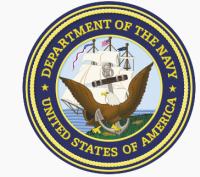 Happy 239th birthday to the United States Navy! On Friday, October 13, 1775, the Continental Congress voted to fit out two armed sailing vessels to cruise to attempt to seize arms and stores from Royal Navy transports. The rebel forces were short of just about everything in the early days of the revolution, so stealing whatever they could from the British was an eminently practical idea. Technically, these ships were the beginning of the Continental Navy and not the United States Navy as the United States did not yet exist. At the end of the Revolutionary War, the Continental Navy was disbanded, the ships sold and the sailors sent home. The US Navy was later authorized by the United States Congress on April 30, 1798. So why does the Navy celebrate their “birthday” on October 13, 1775? And what is Navy Day, and why is it celebrated on October 27?
Happy 239th birthday to the United States Navy! On Friday, October 13, 1775, the Continental Congress voted to fit out two armed sailing vessels to cruise to attempt to seize arms and stores from Royal Navy transports. The rebel forces were short of just about everything in the early days of the revolution, so stealing whatever they could from the British was an eminently practical idea. Technically, these ships were the beginning of the Continental Navy and not the United States Navy as the United States did not yet exist. At the end of the Revolutionary War, the Continental Navy was disbanded, the ships sold and the sailors sent home. The US Navy was later authorized by the United States Congress on April 30, 1798. So why does the Navy celebrate their “birthday” on October 13, 1775? And what is Navy Day, and why is it celebrated on October 27?
After posting yesterday about someone who tried to run 1,000 miles across the Gulf Stream to Bermuda in an inflatable hamster cage, and failed, here is a slightly less insane and more successful example of craziness on the water. The video is more than three years old, but is new to me. Thanks to Bonnie K. Frogma and Bjoern Kils for pointing it out on Facebook. For your viewing pleasure — fire surfing.
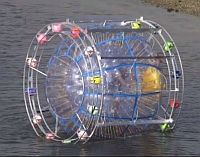 You really can’t make this stuff up. Extreme runner, Reza Baluchi, attempted to run from Florida to Bermuda, a distance of roughly 1,000 miles, in an inflatable bubble with a metal frame, looking something like a giant hamster wheel. It didn’t go well. A few days into the attempt, Baluchi activated a personal locator beacon after becoming disoriented and exhausted. The Coast Guard responded. A chopper lowered a rescue swimmer into the water and found Baluchi lying down inside his bubble. The rescue is estimated to have cost taxpayers roughly $144,000.
You really can’t make this stuff up. Extreme runner, Reza Baluchi, attempted to run from Florida to Bermuda, a distance of roughly 1,000 miles, in an inflatable bubble with a metal frame, looking something like a giant hamster wheel. It didn’t go well. A few days into the attempt, Baluchi activated a personal locator beacon after becoming disoriented and exhausted. The Coast Guard responded. A chopper lowered a rescue swimmer into the water and found Baluchi lying down inside his bubble. The rescue is estimated to have cost taxpayers roughly $144,000.
Now, Baluchi is claiming that he never wanted to be rescued and that he wants his bubble back. Apparently the bubble destroyed when a fishing boat attempted to tow it into port. Baluchi claims that “the transponder button was struck accidentally.” The Coast Guard has a somewhat different view. Coast Guard spokesman, Petty Officer Mark Barney, noted, “He activated both his spot beacon and personal locating beacon. That’s a distress call. When he activated those two things, he was calling for help.”
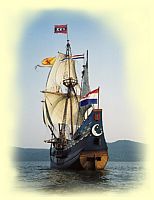 The story is regrettably familiar. A historic vessel, unable to find a suitable berth, is forced to move elsewhere. Yesterday, Chip Reynolds, Director of the New Netherland Museum and Captain of the replica ship, Half Moon, announced the museum’s intentions to move to the ship to the Hoorn in The Netherlands. The replica of the ship Henry Hudson sailed to the river which now bears his name in 1609 has been unable to find a berth on the river.
The story is regrettably familiar. A historic vessel, unable to find a suitable berth, is forced to move elsewhere. Yesterday, Chip Reynolds, Director of the New Netherland Museum and Captain of the replica ship, Half Moon, announced the museum’s intentions to move to the ship to the Hoorn in The Netherlands. The replica of the ship Henry Hudson sailed to the river which now bears his name in 1609 has been unable to find a berth on the river.
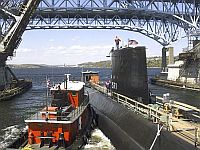 Just over 60 yeas ago, on September 30, 1954, USS Nautilus, the world’s first nuclear powered submarine was commissioned in New London, Connecticut. Following commissioning she continued trials and testing, until she put to sea for the first time on January 17, 1955 and signaled her historic message: “Underway on nuclear power.” USS Nautilus was also the first submarine to complete a submerged transit to the North Pole on 3 August 1958.
Just over 60 yeas ago, on September 30, 1954, USS Nautilus, the world’s first nuclear powered submarine was commissioned in New London, Connecticut. Following commissioning she continued trials and testing, until she put to sea for the first time on January 17, 1955 and signaled her historic message: “Underway on nuclear power.” USS Nautilus was also the first submarine to complete a submerged transit to the North Pole on 3 August 1958.
What made the Nautilus unique was her nuclear reactor, the first to be put on a submarine. Initial testing of the reactor was done, not on the ship, but at a top secret Navy facility, hundreds of miles from the ocean in the high desert of Idaho. Recently the Atlantic Monthly re-posted an article from 1959, by Commander E. E. Kintner, a Navy officer closely involved with the testing. The overall project was managed by then Captain Rickover. From Admiral Rickover’s Gamble:
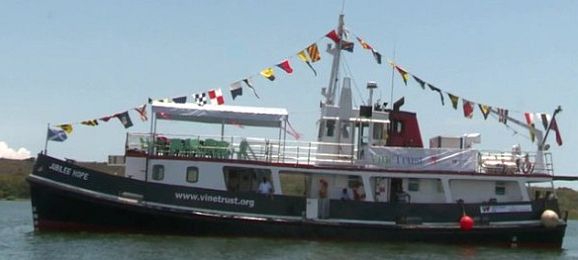 The hospital ship Jubilee Hope was recently christened by the Princess Royal, in Tanzania on Lake Victoria. The 160 ton ship will provide health services to 150 remote island communities with 400,000 people on the large inland lake. She will be operated by Vine Trust, an international charity.
The hospital ship Jubilee Hope was recently christened by the Princess Royal, in Tanzania on Lake Victoria. The 160 ton ship will provide health services to 150 remote island communities with 400,000 people on the large inland lake. She will be operated by Vine Trust, an international charity.
The 8,585 mile voyage of the Jubilee Hope is as remarkable as her new service. She began her life as RMAS Dunster, a Royal Navy tender. Converted to a hospital ship on the Clyde by BAE Systems, the ship has a full dental surgery, operating room, two consulting areas, an eye surgery and a laboratory. It will host life-changing cataract operations, offer a dentistry service and provide help for difficult labors and a range of other healthcare needs.
 Last May we posted that marine archaeologist Barry Clifford had announced that he believed that he had located the wreck of Christopher Columbus’ ship Santa Maria which ran aground and sank on Christmas Day 1492 off Haiti near Cap-Haitien. UNESCO has now scuttled that claim. In a report issued on Monday they concluded that the wreck was farther from shore than historical accounts would indicate and that the fasteners found on the wreck site indicate a technique of ship construction that dates the ship to the late 17th or 18th century rather than the 15th or 16th century. There are also possible signs of copper sheathing, which would put the likely date of the ship wreck in the late 18th century.
Last May we posted that marine archaeologist Barry Clifford had announced that he believed that he had located the wreck of Christopher Columbus’ ship Santa Maria which ran aground and sank on Christmas Day 1492 off Haiti near Cap-Haitien. UNESCO has now scuttled that claim. In a report issued on Monday they concluded that the wreck was farther from shore than historical accounts would indicate and that the fasteners found on the wreck site indicate a technique of ship construction that dates the ship to the late 17th or 18th century rather than the 15th or 16th century. There are also possible signs of copper sheathing, which would put the likely date of the ship wreck in the late 18th century.
UNESCO sinks claim Haiti wreck was Christopher Columbus’s ship
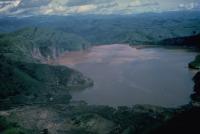
Lake Nyos
We recently posted about video of a “lake monster” in Lake Lagarfljót near Egilsstaðir in Iceland. Notwithstanding that a local panel voted that the “monster” was real, the video has been generally debunked. In Lake Nyos, in the Northwest Region of Cameroon, there is a real lake monster. The deep volcanic crater lake was normally extremely tranquil, yet on August 21, 1986, the lake boiled in great fountains of tumbling water and roiling foam. The waters turned blood red. By dawn, 1,746 people and 3,500 livestock within 25 kilometres of the lake were dead. Atlas Obscura explains what happened:
Another interesting video by Mystic Seaport Museum.
Lighting The Way For Ships: Learning about Lighthouses at Mystic Seaport
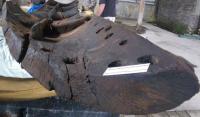 A waka, a 600 year voyaging canoe, was recently found on the New Zealand’s South Island’s West Coast. The results of a study by University of Auckland researchers appeared recently in the US Proceedings of the National Academy of Sciences. The waka, built in New Zealand of matai, an indigenous pine, has direct ties by design and distinctive carvings to the peoples of Eastern Polynesia. Carbon dating showed that the vessel was last caulked with bark around 1400. As reported in Stuff.co.nz: The newly described canoe seems to represent a mix of that ancestral plank technology and an adaptation to the new resources on New Zealand, since the boat has some big, hollowed-out portions but also sophisticated internal ribs, Johns and colleagues wrote.
A waka, a 600 year voyaging canoe, was recently found on the New Zealand’s South Island’s West Coast. The results of a study by University of Auckland researchers appeared recently in the US Proceedings of the National Academy of Sciences. The waka, built in New Zealand of matai, an indigenous pine, has direct ties by design and distinctive carvings to the peoples of Eastern Polynesia. Carbon dating showed that the vessel was last caulked with bark around 1400. As reported in Stuff.co.nz: The newly described canoe seems to represent a mix of that ancestral plank technology and an adaptation to the new resources on New Zealand, since the boat has some big, hollowed-out portions but also sophisticated internal ribs, Johns and colleagues wrote.
The turtle carving on the boat also seems to link back to the settlers’ homeland. Turtle designs are rare in pre-European carvings in New Zealand, but widespread in Polynesia, where turtles were important in mythology and could represent humans or even gods in artwork…. The canoe shares some design elements with a canoe found about 30 years ago on Huahine in the Society Islands.
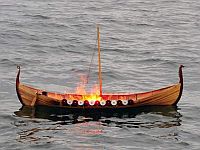
Photo: Petty Officer 2nd Class Cynthia Oldham — Coast Guard
Andrew Haines, a World War II veteran who emigrated from Norway as a child, wanted a Viking funeral. He realized that building a pyre on a full sized Viking ship would be impractical, so Haines decided to build a small replica to carry his ashes. He ultimately built five small boats before deciding on a 54″ model. Andrew Haines, died in late August at age 89 and the US Coast Guard, Station Atlantic City, helped give him the Viking funeral that he had dreamed of for years. On September 29th, Andrew Haines ashes were set into his tiny Viking ship and set ablaze three miles offshore. As reported by the Navy Times:
 In September, we posted about the discovery of one of two missing ships from the Franklin Expedition of 1845. The two missing ships, HMS Erebus and HMS Terror were both originally built as bomb ships. As bomb ships they were built to be extremely strong and as such were especially suitable to be refit as expedition ships for Arctic expeditions. Because the two ships were of roughly the same size and similar in other respects, the archaeologists from Parks Canada were not initially able to identify which of the two ships had been found. They now confirm that the ship wreck located is the HMS Erebus. Sir John Franklin, captain HMS Erebus and in overall command of the expedition, had been searching for the fabled Northwest Passage. HMS Terror has still not been discovered. Thanks to Alaric Bond for passing on the news.
In September, we posted about the discovery of one of two missing ships from the Franklin Expedition of 1845. The two missing ships, HMS Erebus and HMS Terror were both originally built as bomb ships. As bomb ships they were built to be extremely strong and as such were especially suitable to be refit as expedition ships for Arctic expeditions. Because the two ships were of roughly the same size and similar in other respects, the archaeologists from Parks Canada were not initially able to identify which of the two ships had been found. They now confirm that the ship wreck located is the HMS Erebus. Sir John Franklin, captain HMS Erebus and in overall command of the expedition, had been searching for the fabled Northwest Passage. HMS Terror has still not been discovered. Thanks to Alaric Bond for passing on the news.
 Just over a year ago, I was surprised — shocked might be a better word — to hear of a play about a shipyard. The Boat Factory was set in Harland & Wolff of Belfast, the shipyardyard that built theTitanic as well as roughly 1,700 other ships. The play was staged in a small off-Broadway theater and had a cast of only two, yet it was heartfelt and very entertaining. I also suspected that it might be the last play I would ever see about a shipyard. I was wrong.
Just over a year ago, I was surprised — shocked might be a better word — to hear of a play about a shipyard. The Boat Factory was set in Harland & Wolff of Belfast, the shipyardyard that built theTitanic as well as roughly 1,700 other ships. The play was staged in a small off-Broadway theater and had a cast of only two, yet it was heartfelt and very entertaining. I also suspected that it might be the last play I would ever see about a shipyard. I was wrong.
Last night, my wife and I saw the first preview performance of a new Broadway musical, “The Last Ship,” with music and lyrics by Sting and a book by John Logan and Brian Yorkey. Said to be inspired by Sting’s childhood, the musical is set in a shipbuilding town on the Tyneside at the Wallsend Swan Hunter shipyard.
So how was it? I can say without a doubt that it was the best Broadway musical set in a shipyard that I have ever seen. OK, that is setting the bar too low. Continue reading
 In 2011, we posted about the Elissa I.P.A. (India Pale Ale) brewed by the Saint Arnold Brewing Company, which bills itself as Texas’ oldest craft brewery. The Elissa I.P.A. was named after Elissa, the official tall ship of the state of Texas. Every bottle of the limited edition beer sold included a donation toward repairs to the historic ship.
In 2011, we posted about the Elissa I.P.A. (India Pale Ale) brewed by the Saint Arnold Brewing Company, which bills itself as Texas’ oldest craft brewery. The Elissa I.P.A. was named after Elissa, the official tall ship of the state of Texas. Every bottle of the limited edition beer sold included a donation toward repairs to the historic ship.
Now, two breweries in Westchester, NY — Peekskill Brewery and Elmsford-based Captain Lawrence Brewery — are teaming up to create an I.P.A. to benefit the Riverkeeper. The public was invited to help choose the name of the new brew. Of the roughly 300 names suggested, Lucky Sturgeon was the name chosen.
This isn’t supposed to happen. The Hapag-Lloyd 8,749-teu MV Colombo Express and the 8,112-teu MV Maersk Tanjong collided today at the northern end of Egypt’s Suez Canal, near Port Said. No casualties were reported. MV Colombo Express suffered a 20-meter dent on her port bow and lost three containers over the side. The collision is expected to delay traffic in the canal in both directions, pending and investigation and retrieval of the lost containers. From the video and AIS trackof the accident it appears that MV Colombo Express steered into MV Maersk Tanjong
Accident between two vessels in suez canal 29/09/2014 in portsaid
Collision between Colombo Express and Maersk Tanjong off Suez Canal
 The oceans could indeed be older than the sun. A team of scientists from the University of Michigan now believe that up to half the water on our planet is older than the sun. Earlier theories had assumed that interstellar ice particles evaporated with the formation of Earth and reformed later to create the oceans. Now, these scientists have calculated that if the old theory was valid, that the amount of deuterium found in terrestrial water would be far lower than it is. Deuterium is an isotope of hydrogen that has an extra neutron attached. The only explanation they have found for the higher levels of deuterium observed is if more of the interstellar ice particles helped form the world’s oceans directly. They calculate that as much as 50% of the earth’s water might come from these ice particles, which have higher levels of deuterium. This might suggest that water on distant planets is far more common than previously thought.
The oceans could indeed be older than the sun. A team of scientists from the University of Michigan now believe that up to half the water on our planet is older than the sun. Earlier theories had assumed that interstellar ice particles evaporated with the formation of Earth and reformed later to create the oceans. Now, these scientists have calculated that if the old theory was valid, that the amount of deuterium found in terrestrial water would be far lower than it is. Deuterium is an isotope of hydrogen that has an extra neutron attached. The only explanation they have found for the higher levels of deuterium observed is if more of the interstellar ice particles helped form the world’s oceans directly. They calculate that as much as 50% of the earth’s water might come from these ice particles, which have higher levels of deuterium. This might suggest that water on distant planets is far more common than previously thought.
